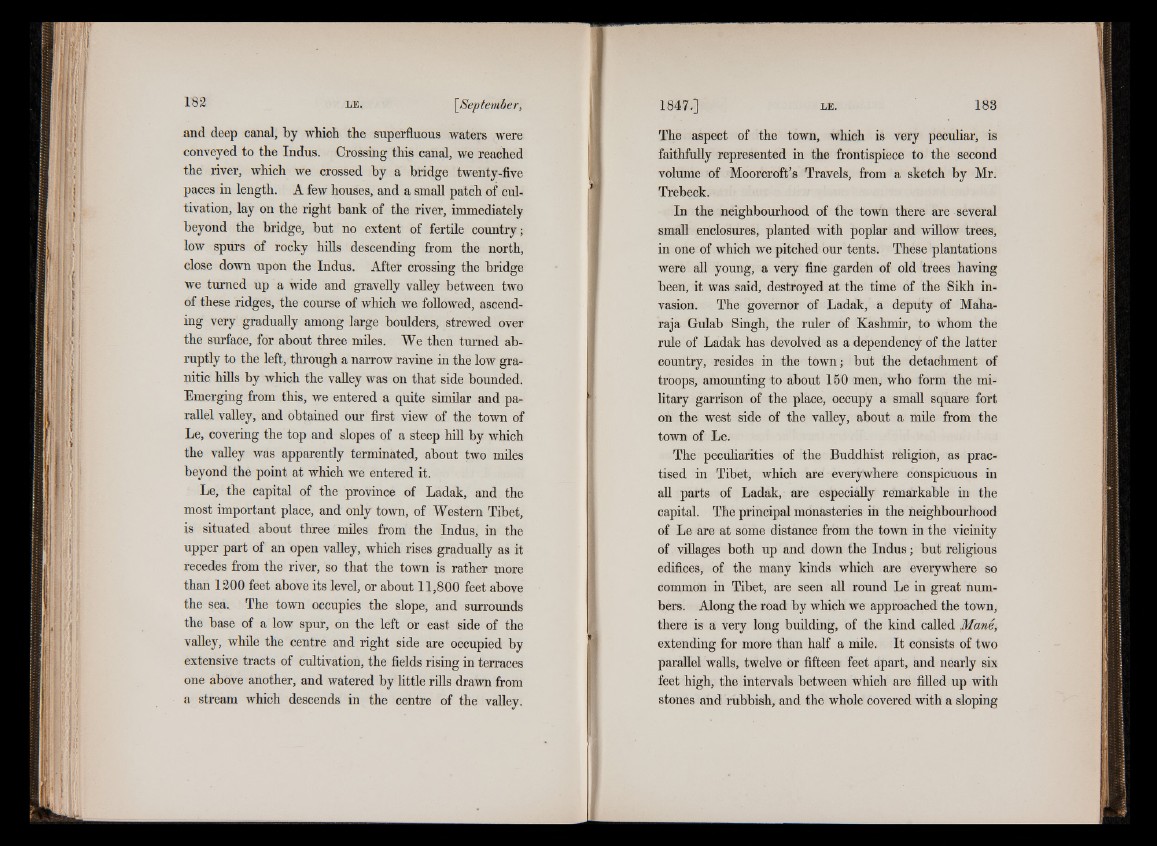
182 LE. [-September,
and deep canal, by wbich the superfluous waters were
conveyed to the Indus. Crossing this canal, we reached
the river, which we crossed by a bridge twenty-five
paces in length. A few houses, and a small patch of cultivation,
lay on the right bank of the river, immediately
beyond the bridge, but no extent of fertile country;
low spurs of rocky hills descending from the north,
close down upon the Indus. After crossing the bridge
we turned up a wide and gravelly valley between two
of these ridges, the course of which we followed, ascending
very gradually among large boulders, strewed over
the surface, for about three miles. We then turned abruptly
to the left, through a narrow ravine in the low granitic
hills by which the valley was on that side bounded.
Emerging from this, we entered a quite similar and parallel
valley, and obtained our first view of the town of
Le, covering the top and slopes of a steep hill by which
the valley was apparently terminated, about two miles
beyond the point at which we entered it.
Le, the capital of the province of Ladak, and the
most important place, and only town, of Western Tibet,
is situated about three miles from the Indus, in the
upper part of an open valley, which rises gradually as it
recedes from the river, so that the town is rather more
than 1200 feet above its level, or about 11,800 feet above
the sea. The town occupies the slope, and surrounds
the base of a low spur, on the left or east side of the
valley, while the centre and right side are occupied by
extensive tracts of cultivation, the fields rising in terraces
one above another, and watered by little rills drawn from
a stream which descends in the centre of the valley.
1847.] LE. 183
The aspect of the town, which is very peculiar, is
faithfully represented in the frontispiece to the second
volume of Moorcroft’s Travels, from a sketch by Mr.
Trebeck.
In the neighbourhood of the town there are several
small enclosures, planted with poplar and willow trees,
in one of which we pitched our tents. These plantations
were all young, a very fine garden of old trees having
been, it was said, destroyed at the time of the Sikh invasion.
The governor of Ladak, a deputy of Maharaja
Gulab Singh, the ruler of Kashmir, to whom the
rule of Ladak has devolved as a dependency of the latter
country, resides in the town; but the detachment of
troops, amounting to about 150 men, who form the military
garrison of the place, occupy a small square fort
on the west side of the valley, about a mile from the
town of Le.
The peculiarities of the Buddhist religion, as practised
in Tibet, which are everywhere conspicuous in
all parts of Ladak, are especially remarkable in the
capital. The principal monasteries in the neighbourhood
of Le are at some distance from the town in the vicinity
of villages both up and down the Indus; but religious
edifices, of the many kinds which are everywhere so
common in Tibet, are seen all round Le in great numbers.
Along the road by which we approached the town,
there is a very long building, of the kind called Mane,
extending for more than half a mile. It consists of two
parallel walls, twelve or fifteen feet apart, and nearly six
feet high, the intervals between which are filled up with
stones and rubbish, and the whole covered with a sloping